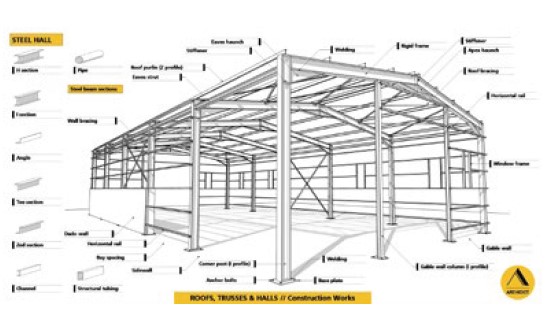Archidict
|
Aimed at facilitating collaboration in international contexts, the dictionary is available in nine languages: English, German, Italian, Spanish, Portuguese, Polish, Hungarian, Greek and Bulgarian. It has the potential for further extensions in the future. |
Anyone involved in managing or working on a building project knows that is only successful if we can understand each other and communicate effectively. Archidict is a response to this fundamental need. The illustrative multilingual dictionary, supported by CIAT, can provide translations, illustrations and pronunciation of technical terminology, supporting architectural and construction projects.
Currently, the 10th language is a universal one: the 3D illustrations derived from models of architectural buildings and structures. The technical illustrations, directly connected to the terminology, provide a clear path to understanding all of the topics.
The drawings act as the main medium to explain names, building techniques, materials and concepts. Additional interactive features, which were tested and fine-tuned in close collaboration with designers, teachers and students, help to build comprehension of the vocabulary.
Archidict has been designed for those who need to learn technical terms in their own, or other, languages. It will support professionals, students and educators by improving their knowledge and offering support in the form of a multilingual learning system. The aim is to encourage their mobility and capability to collaborate, work and study abroad in international contexts.
The dictionary can be accessed at archidict.com/en/.
This article originally appeared in the Architectural Technology Journal (at) issue 137 published by CIAT in spring 2021.
--CIAT
[edit] Related articles
Featured articles and news
The history of building regulations
A story of belated action in response to crisis.
Moisture, fire safety and emerging trends in living walls
How wet is your wall?
Current policy explained and newly published consultation by the UK and Welsh Governments.
British architecture 1919–39. Book review.
Conservation of listed prefabs in Moseley.
Energy industry calls for urgent reform.
Heritage staff wellbeing at work survey.
A five minute introduction.
50th Golden anniversary ECA Edmundson apprentice award
Showcasing the very best electrotechnical and engineering services for half a century.
Welsh government consults on HRBs and reg changes
Seeking feedback on a new regulatory regime and a broad range of issues.
CIOB Client Guide (2nd edition) March 2025
Free download covering statutory dutyholder roles under the Building Safety Act and much more.
AI and automation in 3D modelling and spatial design
Can almost half of design development tasks be automated?
Minister quizzed, as responsibility transfers to MHCLG and BSR publishes new building control guidance.
UK environmental regulations reform 2025
Amid wider new approaches to ensure regulators and regulation support growth.
The maintenance challenge of tenements.
BSRIA Statutory Compliance Inspection Checklist
BG80/2025 now significantly updated to include requirements related to important changes in legislation.
























